Trek to Erg Zhigaga

Beez Neez now Chy Whella
Big Bear and Pepe Millard
Wed 15 Oct 2008 23:50
|
To ERG
ZHIGAGA
After lunch of Tagine of chicken,
bread and water, we jumped into a Toyota 4x4 with Aziz our driver and Abdul our
guide to drive the 60 kms to the famous dunes of Erg Zhigaga.
Some Saharan history. The
climate of the Sahara has undergone enormous variation between wet and dry over
the last few hundred thousand years. During the last ice age, the Sahara was
bigger than it is today, extending south beyond its current boundaries. The end
of the ice age brought better times to the Sahara, from about 8000 BC to 6000
BC, perhaps due to low pressure areas over the collapsing ice sheets to the
north. Once the ice sheets were gone, the northern part of the Sahara dried out.
However, not long after the end of the ice sheets, the monsoon, which currently
brings rain only as far as the Sahel, came further north and counteracted the
drying trend in the southern Sahara. The monsoon in Africa (and elsewhere) is
due to heating during the summer. Air over land becomes warmer and rises,
pulling in cool wet air from the ocean, which causes rain. Paradoxically, the
Sahara was wetter when it received more solar insolation in the summer. Changes
in solar insolation are caused by changes in the Earth's orbital parameters
(9,000 years ago the Earth's axis had a stronger tilt than it does presently,
and perihelion - the sun's closest point to earth - occurred at the end of
July).
 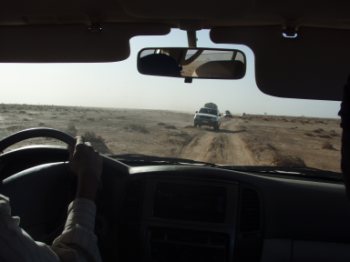  A Tamarisk hump, the tree exudes a sticky substance that sticks the sand into a
protective dune. This keeps the trunk protected from the harsh sun and retains
every drop of moisture. The M2.
Stones.
By around 3400 BC, the monsoon
retreated south to approximately where it is today, leading to the gradual
rather than abrupt desertification of the Sahara. The Sahara is currently as dry
as it was about 13,000 years ago. These conditions are responsible for what has
been called the Sahara Pump Theory. The Sahara has one of the harshest climates
in the world. The prevailing north-easterly wind often causes the sand to form
sand storms and dust devils. Precipitation, while rare, is not unknown. Half of
the Sahara receives less than 2 cm of rain a year, with the rest receiving up to
10 cm a year. The rainfall happens very rarely, but when it does it is usually
torrential when it occurs after long dry periods, which can last for years.
Presently, the climate is changing, and the Sahara is supposedly expanding
southward by about 30 miles per year as stated in the popular
press.
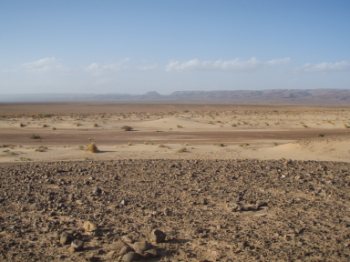  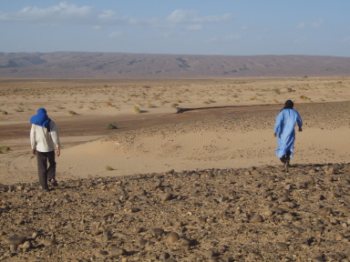 You feel you are standing in a dried out river or lake bed. Our trusty
steed. The boys off searching for fossils to
go in Rita's garden. They came back with so many, knowing exactly what stone to
turn.
Many people only picture the Sahara
as rolling sand dunes known as ERG, but there are extensive gravel plains known
as REG. The other aspects of the Saharan landscape include the HAMMADAS:
vast plateaus swept by winds; and massive mountains. Only about 10-30% of the
Sahara is actually covered by sand ( depending which report you read ), and
parts of the Sahara are in fact covered by soil. More than half of the area
comprises soils known as yermosols, with shallow profiles over gravel or pebble
beds. These soils have been developing over the past 50 million years.
   A real oasis that has
been used by caravans for hundreds of years. Lush
vegetation. A water pool.
Recent work using remote sensing radar has
revealed ancient river beds under the sands of the Sahara. Pollen records
indicate that the Sahara was covered by savannah and steppe vegetation as
recently as 5,500 years ago.
   I almost fell over, the silence was broken by the
alarmed shouting of a gang of frogs, not what I had
expected in the middle of the Sahara. Then a dog
appeared. An abandoned nomad hospital, sadly closed
two years ago and relocated.
  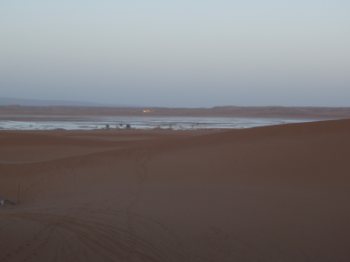 A real caravan. A dead
donkey not that far from water will become carrion after 5 days -
The birds of prey like their meat tenderised, the smell was awesome. The very shallow lake helped by the recent rain, I made the
Berber's at camp laugh when I said "I'm responsible for your rain, I offered to
drive for Sammy". The next morning in true tradition Bear and I touched the
water and wished it to remain throughout the winter.
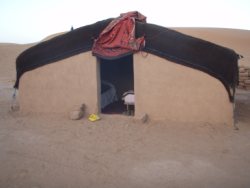 

 Our bivouac. A double
and single bed within, I checked round at bed time to see if any unwanted
visitors where with us - not a one. The room was warm, not too hot, with a
gentle breeze through the upturned doorway. We read by candlelight before
settling down to sleep. The boys putting out the
blankets ready for supper. A view of camp and
the ' food hall ' on the left, you can see our home to the right of the food
hall with the thick curtain door open.
 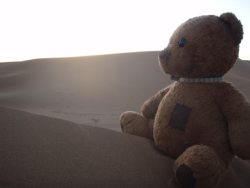   The reason for being at Erg
Zhigaga ( pronounced erg shi garger ) is the sheer size of the dunes, the
biggest at over 350 feet. Beds resting on the way to
the top after a tiring climb. Bear with Beds. Made it. It was at the top Bear looked
down and saw a scorpion trail, we stayed long enough to enjoy the sunset and
videoed each other rolling down.
The sand is
primarily derived from weathering of Cretaceous sandstones in North Africa. When
these sandstones were deposited in the Cretaceous, the area where they are now
was a shallow sea. The original source of the sand was the large mountain ranges
that still exist in the central part of the Sahara. These mountains are volcanic
and intrusive, and the granite rock weathers out to leave behind quartz sand
grains that are carried by rivers to the sea. These sand deposits eventually
formed into sandstone, and as they were uplifted began to weather and break down
into sand again. 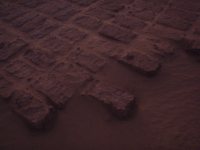  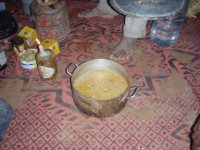   Traditionally made bricks baked
in the sun, cut and stacked for repair work and the new Bivvy being
built. The builders invited to their home whilst our supper was cooking. Their goat stew supper. A real
nomad who has visited camp for over twenty years and just by speaking to
the tourists has learned six or seven languages. A full
moon lit the night sky, but we still managed to see many
stars.
 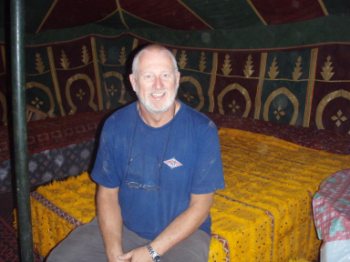  Taking a look inside the food
hall, Bear fresh off the dunes, cleaned up ready for
Tagine of chicken, vegetables, bread and water. Great coffee to
follow.
All in all a very different adventure in the
blazing heat.
|